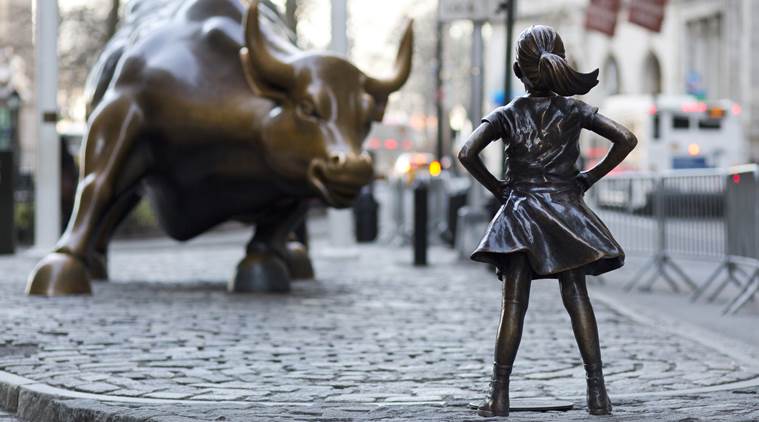Stay updated with the latest - Click here to follow us on Instagram
Red rag to a bull
As a little girl pops up on Wall Street, what does its mean, what it doesn’t, and should it stay?
 In this March 22, 2017 photo, the Charging Bull and Fearless Girl statues are sit on Lower Broadway in New York. Since 1989 the bronze bull has stood in New York City’s financial district as an image of the might and hard-charging spirit of Wall Street. (AP Photo/Mark Lennihan)
In this March 22, 2017 photo, the Charging Bull and Fearless Girl statues are sit on Lower Broadway in New York. Since 1989 the bronze bull has stood in New York City’s financial district as an image of the might and hard-charging spirit of Wall Street. (AP Photo/Mark Lennihan)
For close to three decades, the iconic ‘Charging Bull’ — the over three-tonne bronze statue of a snorting bull — held the pride of place on Wall Street, in the process becoming synonymous with Manhattan’s Financial District. Stealthily dropped onto lower Manhattan by its creator, sculptor Arturo Di Modica, in December 1989, it was, according to Modica, a symbol of virility and courage — “the perfect antidote to the Wall Street crash of 1986”.
But the bull’s thunder has been stolen, literally from right under its nose, by another bronze statue that popped up right in front of it on March 7, on the eve of International Women’s Day. Commissioned by the Boston-based financial firm State Street Global Advisors and sculpted by Kristen Visbal, ‘Fearless Girl’ — of a defiant child with her fists on her hips — is meant to represent “the power of women in leadership”, its makers say.
And since it has come up, The Atlantic says, thousands of people have taken selfies with the diminutive figure and signed petitions asking the city to make the temporary artwork a permanent one. According to Forbes, Chelsea Clinton tweeted that Manhattan had “some new art with a powerful message”. New York City Mayor Bill de Blasio credited the sculpture with fuelling “powerful conversations about women in leadership”.
 Sculptor of ‘Raging Bull’ before whom the girl has been put, Arturo Di Modica (above), believes it transforms the ‘positive, optimistic message’ of his work
Sculptor of ‘Raging Bull’ before whom the girl has been put, Arturo Di Modica (above), believes it transforms the ‘positive, optimistic message’ of his work
All this hasn’t gone down too well with Arturo Di Modica, who told The New York Times that ‘Fearless Girl’ had transformed the “positive, optimistic message” of his work into “a negative force and threat”.
In response, Mayor de Blasio tweeted, “Men who don’t like women taking up space are exactly why we need the Fearless Girl.” He added that the statue would stay put in its place till 2018.
A “wounded” Di Modica has now threatened to sue the city, but he may not have a legal case, writes Jeff John Roberts in Fortune. “Unlike other countries, the United States has very weak protection for ‘moral rights’, which help artists protect the integrity of their work. Di Modica faces a number of hurdles to invoking the US version of moral rights, known as the Visual Artist Protection Act, or VARA. These include the fact that VARA only allows artists to stop the ‘distortion’ or ‘mutilation’ or their work, or prevent modifications that would harm their ‘honour or reputation’. So while Di Modica can argue that the presence of ‘Fearless Girl’ changes the message of his work (it transforms the overall tableau from roaring capitalism to female empowerment), it’s hard to see how this is a mutilation or how it hurts his reputation,” Roberts writes.
While he may be on a slippery legal slope, the sculptor has sympathisers, particularly on his assertions that Fearless Girl eats into the very essence of his work. “Before Fearless Girl came on the scene, the bull was an encouraging representation of a booming economy. Now, charging toward a tiny human, it’s a stand-in for the gendered forces that work against women’s success in the workplace,” writes Christina Cauterucci in Slate.
Even the optics have been called into question, with some critics accusing it of “infantilising” the fight for gender equality. “I’m not immune to the appeal this statue has for tourists, especially when it comes to the crowds of little girls crowding around the statue, having their pictures taken. But even the fact that this statue is so popular should be the first clue about how toothless it is. Girl power is widely popular, not just on the left but increasingly on the right. Almost everyone loves the idea of little girls being proud and strong and getting good grades and being good at sports. But the second those A-student girls grow up into women who want good jobs and egalitarian marriages and maybe even a shot at the presidency, suddenly people stop being so enthusiastic,” writes Amanda Marcotte in The Salon.
Cara Marsh Sheffler, writing in The Guardian, argues that the statue sums up what is wrong with feminism today. “Feminism is about human decency, not moulding young girls in the image of a banking industry that bets against us, shorts us, and then receives government bailout money… Do we need women at the top of the ladder? Making big decisions? Calling the shots? We sure do. We also need more women and men of colour as captains of industry. However, let’s remember why: so that they can understand, represent, and remember the needs of the undeserved, of those who didn’t go straight from Harvard Business School to a hedge fund without a care in the world. We don’t need women at the top of industry who have kicked out the ladder from under them — just like the men who came before them,” she writes.
Others have questioned the intentions of the financial firm that commissioned the work. Ginia Bellafante writing in The New York Times points out that of the company’s 28-person leadership team, only five are women. It is worth considering the timing of State Street’s diversity call, she writes, adding that after an FBI inquiry in January this year, State Street Corporation, the parent company of State Street Global Advisors, had agreed to pay over $64 million to resolve fraud charges. “State Street had fleeced its clients, prosecutors maintained by secretly billing for unwarranted commissions and, as a result, had abused their trust and caused them to lose substantial amounts of money. A spokeswoman for the company dismissed any connection between the action and State Street’s broad diversity agenda, pointing out that the government’s inquiries began seven years ago,” Bellafante writes.
Not everyone, however, wants Fearless Girl to go. An editorial in the Chicago Tribune has batted for both artworks to remain where they are. “One doesn’t detract from the other, any more than a Van Gogh and a Monet in the same museum battle for attention. We think the girl enhances the presence of the bull … and the bull underscores the resolve of the little girl with feet planted firmly against whatever comes next,” the editorial reads. “Our advice to New York: Don’t blow this serendipitous pairing. The statue face-off could attract tourists by the busload. What city wouldn’t relish such a magnet? This is like Cubs or Sox, Beyonce or Rihanna, Muhammad Ali or Joe Frazier, John or Paul. In other words: The rivalry is good for business… Settle this tussle now. We say the girl stays,” it adds.
Gail Collins though believes that ‘Fearless Girl’ doesn’t need any bull. “‘Fearless Girl’ looks like she’s capable of multitasking. And she doesn’t need to stay in the city… How many of you out there can think of something in your state that deserves to be set back in its tracks by an extremely determined-looking young lady? Environmentalists could buy her and set her down on Florida’s coastline at flood time, pushing back on global warming. Maybe she’d like to take another crack at stopping the Keystone pipeline. The next time protesters come to Occupy Wall Street, they could bring their girl along. Personally, I vote for Lafayette Park, across from the White House. Can you imagine her standing there, facing down Donald Trump every day?” she writes in The New York Times.
Curated by Arun Prashanth Subramanian






- 01
- 02
- 03
- 04
- 05

























